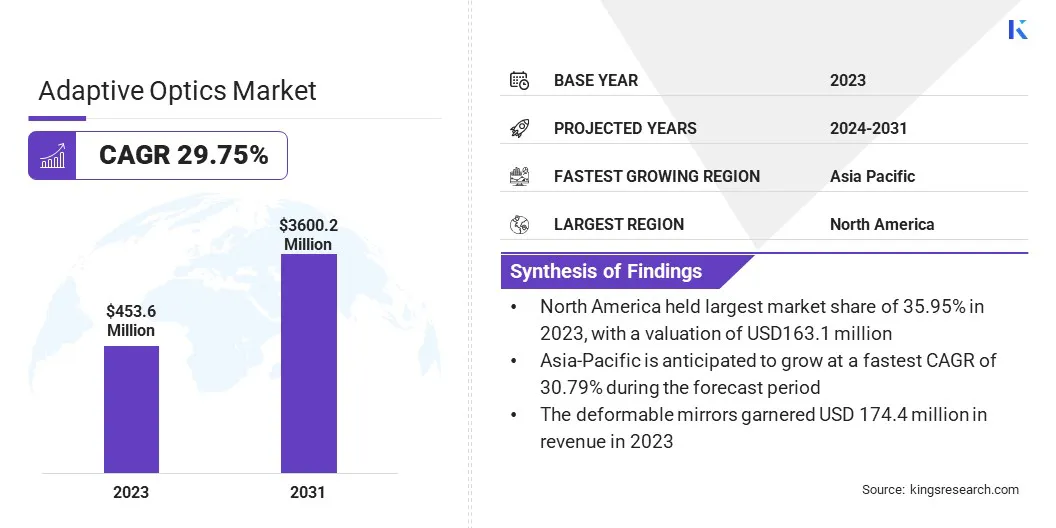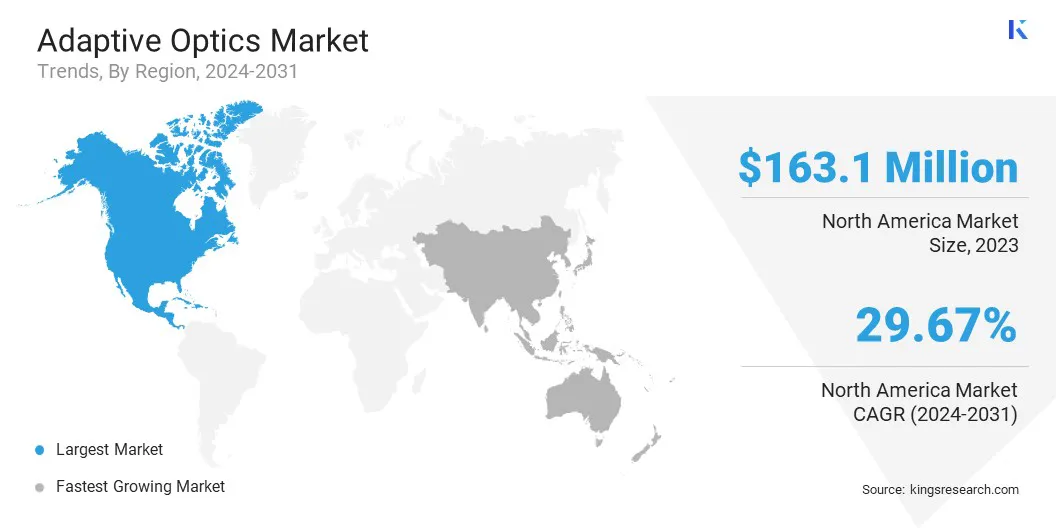Market Definition
The market focuses on advanced optical systems that dynamically correct wavefront distortions in real time. Key sectors in this market include astronomy, defense, healthcare, and telecommunications.
The market is driven by the growing need for high-precision optical solutions, with innovations in deformable mirrors, wavefront sensors, and control systems, featuring major players from defense, medical, and research industries. The report outlines the major factors driving the market, along with key drivers and the competitive landscape shaping its growth trajectory over the forecast period.
Adaptive Optics Market Overview
The global adaptive optics market size was valued at USD 453.6 million in 2023 and is projected to grow from USD 581.7 million in 2024 to USD 3600.2 million by 2031, exhibiting a CAGR of 29.75% during the forecast period.
The global market is expanding, fueled by advancements in autonomous vehicles, AI-driven performance, and rising demand for personalized vision correction in medical & consumer sectors.
Major companies operating in the adaptive optics industry are Edmund Optics Inc, Benchmark Electronics Inc., Thorlabs, Northrop Grumman, Phasics., Flexible Optical B.V., Adaptica, BERTIN TECHNOLOGIES , Imagine Optic, Celestron, Synopsys, Inc., AOSense, Inc., Teledyne Technologies Incorporated, asphericon, and JENOPTIK AG.
The market is registering significant growth, driven by the increasing use of Adaptive Optics (AO) technology in vision correction for both medical and consumer applications. AO enables high-resolution, personalized vision correction for ophthalmic devices and optical systems, effectively addressing refractive errors and retinal diseases.
Demand for customized eyewear and innovative treatment solutions continues to rise, creating substantial opportunities for companies in the medical device and consumer optics sectors.
- In September 2024, a study by Michael Balas, Department of Ophthalmology and Vision Sciences, University of Toronto, Canada highlighted the importance of AO imaging. AO is revolutionizing ophthalmology by providing exceptional retinal resolution, significantly improving early disease detection and monitoring. This technology enhances the understanding of ocular pathologies and is setting the stage for future innovations, creating opportunities for advanced diagnostic solutions in the market.

Key Highlights:
- The adaptive optics industry size was valued at USD 453.6 million in 2023.
- The market is projected to grow at a CAGR of 29.75% from 2024 to 2031.
- North America held a market share of 35.95% in 2023, with a valuation of USD 163.1 million.
- The deformable mirrors segment garnered USD 174.4 million in revenue in 2023.
- The ophthalmology segment is expected to reach USD 884.2 million by 2031.
- The market in Asia Pacific is anticipated to grow at a CAGR of 30.79% during the forecast period.
Market Driver
Autonomous Vehicle Integration
The market is registering significant growth, driven by the increasing demand for precise optical systems in autonomous vehicles. Autonomous vehicles rely on advanced navigation and sensor technologies, which makes AO crucial for improving the performance of lidar, cameras, and radar systems. Innovations in real-time imaging, object detection, and environmental adaptation are creating substantial opportunities for companies in the automotive and optics industries.
- .In February 2023, the World Economic Forum reported advancements in autonomous driving, supported by Statista's forecast that 63.6% of global passenger cars will feature Level 1 automation by 2025. This growth is fueling the demand for advanced optical systems and AO technology to improve sensor performance and navigation capabilities.
Market Challenge
High System Costs
The global adaptive optics market faces a significant challenge, due to the high cost of technology. The complexity and precision required for developing, producing, and maintaining AO systems result in expensive solutions, limiting widespread adoption, especially in medical and consumer markets.
Manufacturers in the market can focus on advancing manufacturing techniques and collaborative partnerships to reduce production costs. Additionally, software optimization and miniaturization of components can drive affordability while maintaining performance.
Market Trend
Integration of Artificial Intelligence and Machine Learning
The global market is registering a significant trend with the integration of Artificial Intelligence (AI) and Machine Learning (ML) algorithms to enhance real-time performance.
This integration improves turbulence correction and boosts efficiency across various applications, including quantum communication, biomedical imaging, and autonomous vehicles, fostering innovation and creating substantial growth opportunities in the market.
- In March 2025, the University of Ottawa published a breakthrough in AO for quantum key distribution (QKD), combined with AI, demonstrating its ability to correct turbulence in real time. This innovation significantly enhances security and key generation rates, propelling free-space quantum communication into a new era. It enables secure quantum communication under extreme conditions, offering substantial opportunities for developing scalable quantum networks and ground-to-satellite communication.
Adaptive Optics Market Report Snapshot
|
Segmentation
|
Details
|
|
By Component
|
Deformable Mirrors, Wavefront Sensors, Control System
|
|
By End Use
|
Ophthalmology, Microscopy, Laser Application, Manufacturing, Communications, Military & Defense, Others
|
|
By Region
|
North America: U.S., Canada, Mexico
|
|
Europe: France, UK, Spain, Germany, Italy, Russia, Rest of Europe
|
|
Asia-Pacific: China, Japan, India, Australia, ASEAN, South Korea, Rest of Asia-Pacific
|
|
Middle East & Africa: Turkey, U.A.E., Saudi Arabia, South Africa, Rest of Middle East & Africa
|
|
South America : Brazil, Argentina, Rest of South America
|
Market Segmentation:
- By Component (Deformable Mirrors, Wavefront Sensors, Control System): The deformable mirrors segment earned USD 174.4 Million in 2023, due to their critical role in improving image quality by precisely correcting wavefront distortions in real time, driving widespread adoption across astronomy, defense, and medical applications.
- By End Use (Ophthalmology, Microscopy, Laser Application, and Manufacturing): The ophthalmology segment held 24.47% share of the market in 2023, due to the increasing demand for advanced retinal imaging and diagnostic tools that enhance precision in detecting and treating eye disorders.
Adaptive Optics Market Regional Analysis
Based on region, the global market has been classified into North America, Europe, Asia Pacific, Middle East & Africa, and Latin America.

North America accounted for a market share of around 35.95% in 2023, with a valuation of USD 163.1 million. North America dominated the global adaptive optics market, as countries in the region, especially the U.S., is a hub for leading companies and research institutions specializing in the technology.
These organizations focus heavily on research and development, driving the creation of advanced AO technologies. These innovations are essential across various industries, including astronomy, defense, and medical imaging, reinforcing North America's position at the forefront of AO advancements.
- In July 2024, the American Medical Association reported a 4.1% increase in U.S. health spending in 2022, totaling $4.5 trillion. This return to pre-pandemic spending trends, driven by increased utilization of medical services, is boosting demand for advanced diagnostic technologies- such as adaptive optics systems- particularly in high-resolution retinal imaging and ophthalmic diagnostics.
The market in Asia-Pacific is poised for significant growth at a robust CAGR of 30.79% over the forecast period. The market in the region is driven by the expanding consumer electronics sector, where the rising demand for high-quality displays and advanced imaging systems in smartphones, cameras, and other devices is prompting manufacturers to integrate AO. This trend is fueling the market, particularly in electronics hubs like China, Japan, and South Korea.
Regulatory Frameworks
- European Medicines Agency (EMA) and CE Marking: In Europe, medical devices, including those incorporating AO technology, must comply with the Medical Device Regulation (MDR), which ensures safety and performance standards. A CE mark is required for commercial sale in the EU.
- Health Canada: AO systems used in healthcare must adhere to Health Canada's medical device regulations.
Competitive Landscape
The global adaptive optics market is becoming increasingly competitive with strategic acquisitions, such as Bertin Technologies’ acquisition of ALPAO in 2024. This merger strengthens Bertin Alpao’s position in the photonics market, combining expertise to enhance capabilities in scientific and critical applications, driving innovation and market leadership.
- In July 2024, Bertin Technologies successfully completed the acquisition of ALPAO, a Grenoble-based leader in AO. ALPAO, known for its advanced systems and components that enhance image quality in challenging environments, will now contribute its expertise to Bertin Technologies. This strategic acquisition strengthens Bertin Alpao’s position as a dominant force in the photonics sector, further enhancing its capabilities in scientific and critical applications, and positioning the group for continued growth and innovation.
List of Key Companies in Adaptive Optics Market:
- Edmund Optics Inc.
- Benchmark Electronics, Inc.
- Thorlabs
- Northrop Grumman
- Phasics
- Flexible Optical B.V.
- Adaptica
- BERTIN TECHNOLOGIES
- Imagine Optic
- Celestron
- Synopsys Inc.
- AOSense Inc.
- Teledyne Technologies Incorporated
- asphericon
- JENOPTIK AG
Recent Developments (Collaboration/ Launch)
- In March 2025, Microgate's AO technology was central to a collaboration with the European Southern Observatory (ESO) to develop adaptive mirrors for the Extremely Large Telescopes (ELTs). This partnership enhances capabilities for deep space exploration, providing notable benefits in terms of size and versatility compared to space-based telescopes, thereby advancing the field of astronomical research.
- In June 2024, ONERA accomplished a significant milestone by successfully establishing a stable two-way laser link with the Airbus Defense and Space TELEO payload in geostationary orbit. This achievement, made possible through the use of AO and high-power lasers, opens the door to secure, high-capacity optical communication links between ground and space systems.


